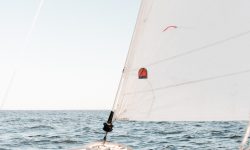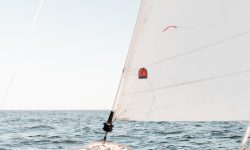Welcome to the thrilling world of sailing! Whether you are an experienced sailor or a newbie, this blog post will provide you with a comprehensive guide to help you navigate the captivating realm of sailing. From the art of sailing to essential gears, safety tips, mastering sailing knots, navigating the high seas, and exploring epic sailing destinations, we have got you covered. So, grab your sailing gear and get ready for an exhilarating adventure on the open waters.
The Art Of Sailing ⏬
Sailing is not just a hobby or a sport, it is an art. It requires passion, skill, and a deep understanding of the forces of nature. From the moment you step onto a sailboat, you are embarking on a journey that combines both science and art. The art of sailing involves harnessing the power of the wind, understanding the dynamics of the water, and navigating the vastness of the sea.
One of the key elements in mastering the art of sailing is understanding how to use the wind to your advantage. The wind is your driving force, and it is essential to learn how to read it. You need to be able to identify the wind direction and adjust your sails accordingly. This involves trimming the sails, adjusting the angle and position to maximize the propulsion. A strong gust of wind can propel the sailboat forward with great speed, while a calm breeze requires finesse and patience.
Another important skill in sailing is understanding the art of navigation. Before setting sail, it is crucial to study charts, maps, and weather forecasts. This will help you plan your route, avoid potential hazards, and make the most of your sailing experience. As you navigate the waters, you must also be aware of your surroundings and keep a keen eye out for any obstacles, such as rocks, reefs, or other vessels. The art of sailing lies in your ability to navigate through these challenges with precision and grace.
| Sailing on or about | Safety Tips For Sailing | Mastering Sailing Knots |
|---|---|---|
| Sailing on a calm sea can be a serene and peaceful experience. The gentle sway of the boat, the sound of the water lapping against the hull, and the feeling of freedom as you glide through the water can be truly magical. On the other hand, sailing about in rough seas can be a thrilling and adrenaline-pumping adventure. The crashing waves, the white foam, and the challenge of taming the untamed sea can be an exhilarating experience for any sailor. | When it comes to safety, there are several important tips to keep in mind while sailing. Firstly, it is crucial to always wear a life jacket and ensure that all passengers on board do the same. You never know when an unexpected accident or emergency could occur, and a life jacket can save your life. Additionally, it is important to have a safety kit on board, including a first aid kit, flares, and a whistle to signal for help if needed. Lastly, always be aware of the weather conditions and never sail in severe storms or when there is a high risk of lightning. | Mastering the art of sailing also involves mastering the art of tying knots. There are various types of knots that are essential for different purposes while sailing. Some common sailing knots include the bowline knot, which is used for securing a line to a post or ring, and the clove hitch, which is useful for attaching a line quickly and easily. Learning how to tie and untie these knots with ease is essential for any sailor. |
Essential Gear For Sailing 👇
When it comes to sailing, having the right gear is essential for both safety and enjoyment on the water. Whether you are a seasoned sailor or just starting out, having the necessary gear can make all the difference in your experience. In this blog post, we will explore some of the essential gear that every sailor should have before setting sail.
1. Life Jacket: Safety should always be the top priority when sailing. A life jacket is a must-have item for every sailor, regardless of their experience level. It is designed to keep you afloat in case of an accident or emergency. Make sure to choose a life jacket that fits properly and is approved by the appropriate authorities.
2. Sailing Gloves: Sailing gloves are an important piece of gear that can protect your hands from rope burns and blisters. They provide a better grip on wet surfaces and help to improve your overall performance while handling the sail. Look for gloves that are durable, comfortable, and offer good dexterity.
3. Waterproof Bag: A waterproof bag is essential for keeping your personal belongings safe and dry while onboard. It provides protection against water damage and ensures that your essentials, such as cell phones, wallets, and extra clothing, stay dry and secure. Opt for a bag that is spacious, lightweight, and easy to carry.
4. Binoculars: Navigating the open water requires good visibility, and a pair of binoculars can greatly enhance your ability to spot potential hazards or interesting sights. They are especially useful for identifying other boats, landmarks, or marine wildlife in the distance. Choose binoculars that are waterproof, fog-proof, and have a good magnification power.
5. Portable VHF Radio: Communication is vital while sailing, and a portable VHF (Very High Frequency) radio is a crucial piece of gear for staying connected with other boats, marinas, or emergency services. It allows you to communicate important information and receive updates on weather conditions or any emergencies in the area.
6. Navigation Tools: While modern technologies like GPS have simplified navigation, it is still essential to have traditional navigation tools as a backup. Items like a reliable compass, nautical charts, dividers, and parallel rules can help you navigate even if your electronic devices fail. Familiarize yourself with these tools and practice using them before setting sail.
7. Safety Knife: A safety knife is a versatile tool that can come in handy in various situations while sailing. It can be used to cut through ropes, fishing lines, or any other material that may pose a risk. Look for a knife that is made of corrosion-resistant materials and has a serrated edge and a rounded tip for added safety.
Essential Gear Description Life Jacket Keeps you afloat in emergencies Sailing Gloves Protects hands and improves grip Waterproof Bag Keeps personal belongings dry and secure Binoculars Enhances visibility and spotting potential hazards Portable VHF Radio Allows communication with other boats and services Navigation Tools Traditional tools for backup navigation Safety Knife Useful for cutting ropes and materials
These are just a few examples of the essential gear for sailing. Remember that safety should always be a priority, so make sure to invest in quality gear that meets the necessary standards. Enjoy your time on the water and happy sailing!
Safety Tips For Sailing
Sailing is a thrilling and adventurous activity that allows individuals to explore the vastness of the open seas. However, just like any other outdoor recreational pursuit, it is essential to prioritize safety when sailing. Whether you are a seasoned sailor or a beginner, adhering to certain safety tips is crucial for a smooth and secure sailing experience. In this blog post, we will discuss some key safety measures and precautions that every sailor should keep in mind while embarking on their sailing journey.
1. Wear Proper Safety Gear
Before setting sail, ensure that you and your crew are equipped with the necessary safety gear. This includes life jackets or personal flotation devices (PFDs) for each person on board. Make sure that the life jackets fit properly and are in good condition. Additionally, it is crucial to have harnesses, safety tethers, and helmets on board, especially in challenging weather conditions or rough waters.
2. Check Weather Conditions
Prior to sailing, always check the weather forecast for the duration of your trip. Pay attention to any potential storms, high winds, or adverse conditions that may pose a risk to your safety. Stay informed about weather updates throughout your journey as conditions can change rapidly at sea. If the weather becomes inclement, consider adjusting your sailing plans and seeking shelter until conditions improve.
3. Practice Safe Navigation
Proper navigation is crucial when sailing to ensure the safety of both your vessel and crew. Familiarize yourself with local sailing rules, navigational aids, and charts specific to the area you are sailing in. Keep a close eye on your surroundings, be aware of other boats or marine traffic, and avoid areas with potential hazards such as rocks or shallow waters. Always have a designated lookout to help maintain a clear watch.
4. Communicate and Establish Safety Procedures
Before setting sail, establish clear communication and safety procedures with your crew. Ensure that everyone knows their roles and responsibilities, as well as emergency protocols. Create a checklist for regular safety inspections of the boat, including checking the integrity of ropes, riggings, and equipment. It is also essential to establish a communication plan in case of emergencies, including distress signals and means of contacting the shore or nearby boats.
5. Be Prepared for Emergencies
No matter how prepared you are, emergencies can still occur while sailing. Therefore, it is crucial to have appropriate safety equipment and emergency provisions on board. This may include a well-stocked first-aid kit, fire extinguisher, distress signals, a life raft, and a reliable means of communication such as a VHF radio or satellite phone. Additionally, ensure that all crew members are aware of emergency procedures and know how to respond in different scenarios.
Essential Checklist for Sailing Safety
By following these safety tips and being prepared for any situation, you can ensure a smooth and enjoyable sailing experience while minimizing potential risks. Remember, safety should always be the top priority when venturing out on the open seas. Happy sailing!
Mastering Sailing Knots
Sailing is not only a great way to explore the open waters and indulge in adventurous experiences, but it also requires a certain level of skill and knowledge. One such essential skill for any sailor to master is the art of tying knots. Properly tying knots is crucial for ensuring the safety and security of your boat, equipment, and crew while out on the water. Whether you are a seasoned sailor or just starting your sailing journey, understanding and mastering sailing knots is a skill worth acquiring.
When it comes to sailing, there is a wide array of knots that every sailor should be familiar with. One such knot is the bowline knot, which is often referred to as the “king of knots.” This versatile knot creates a secure loop that doesn’t slip or come undone, making it ideal for various sailing tasks such as securing the halyard, attaching sheets, or rescuing someone overboard.
Another important knot in the sailor’s repertoire is the clove hitch. This knot is simple to tie and untie, making it perfect for securing fenders to the railing or attaching a line to a bollard. Its ability to grip tightly without slipping ensures the safety of your boat in challenging conditions.
- Additionally, the figure-eight knot is a knot that every sailor should be familiar with. This knot is primarily used to prevent the end of a line from passing through a block or a cleat. Its simple structure and ease of tying make it a reliable choice for securing various boat riggings.
| Knot | Usage |
|---|---|
| Bowline knot | Securing the halyard, attaching sheets, rescuing someone overboard |
| Clove hitch | Securing fenders, attaching a line to a bollard |
| Figure-eight knot | Preventing line slippage through a block or a cleat |
These are just a few examples of the essential sailing knots that every sailor should master. Each knot serves different purposes and can be employed in various situations while sailing. It is important to practice tying these knots until you can do so confidently and quickly, as you may need to rely on them in unpredictable conditions.
Remember, when sailing, your safety and that of your crew depend on your ability to secure equipment and execute swift maneuvers. The mastery of sailing knots is not only practical but also enhances your overall sailing experience. So, set aside some time to practice and familiarize yourself with the essential sailing knots, and you’ll be well-prepared to navigate the open seas with confidence and ease.
Navigating The High Seas
The high seas have always held a certain allure and mystique for sailors, and for good reason. Navigating these vast expanses of open water requires skill, knowledge, and an understanding of the elements. Sailing on the high seas can be an exhilarating and rewarding experience, but it is not without its challenges. In this blog post, we will explore the art of navigating the high seas and discuss some essential tips and techniques to ensure a safe and successful voyage.
Navigating the high seas is a complex task that requires a combination of traditional and modern navigation techniques. One of the most important tools in a sailor’s arsenal is a nautical chart, which is essentially a map of the sea. Nautical charts provide valuable information such as water depths, landmarks, and navigational hazards. They also indicate key features like shipping lanes and buoy systems, which are essential for safe navigation.
Sailing on the high seas also requires an understanding of celestial navigation. Before the advent of modern technology, sailors relied on the stars, sun, and moon to determine their position at sea. Today, GPS and other electronic navigation systems have made this task much easier, but it is still important for sailors to have a basic understanding of celestial navigation as a backup in case of equipment failure.
Essential Navigation Equipment
When sailing on the high seas, it is important to constantly monitor weather conditions and adapt your course accordingly. Storms and rough seas can pose significant challenges, so it is crucial to have access to accurate weather forecasts and have a plan in place for severe weather situations. Additionally, maintaining a safety checklist and ensuring that all safety equipment is in good working order is essential for a successful voyage.
In conclusion, navigating the high seas is a skill that requires a combination of experience, knowledge, and preparation. Whether you are embarking on a short coastal passage or a transoceanic adventure, being well-equipped and familiar with the art of navigation is crucial for a safe and enjoyable journey.
Exploring Epic Sailing Destinations
Sailing is a beloved pastime for many adventure seekers and nature lovers alike. There’s nothing quite like the feeling of gliding over the open waters, the wind in your hair and the spray of the sea on your face. But for those who have already mastered the art of sailing, it’s time to take your skills to the next level and explore some truly epic sailing destinations. In this blog post, we will take a look at some of the most breathtaking and captivating sailing destinations around the world.
One of the most iconic sailing destinations in the world is the Mediterranean Sea. With its crystal-clear waters, stunning coastlines, and rich history, the Mediterranean offers an unforgettable sailing experience. From the beautiful islands of Greece to the Amalfi Coast in Italy, there are endless opportunities to explore picturesque harbors, dine on delicious local cuisine, and soak up the sun on pristine beaches.
If you’re looking for something more off the beaten path, why not set sail for the remote islands of the South Pacific? From Fiji to Tahiti, these islands offer a true paradise for sailors. Imagine cruising through turquoise waters, anchoring in secluded bays, and snorkeling among vibrant coral reefs. The South Pacific is a dream destination for those seeking tranquility and a connection with nature.
Destination Key Features Greek Islands Idyllic beaches, ancient ruins, delicious cuisine Amalfi Coast, Italy Breathtaking coastal cliffs, charming towns, world-class cuisine Fiji Remote islands, crystal-clear waters, vibrant marine life Tahiti Stunning lagoons, overwater bungalows, rich Polynesian culture
If you prefer a more adventurous sailing experience, set your course for the exotic Galapagos Islands. Located in the Pacific Ocean, these islands are famous for their unique wildlife and untouched natural beauty. Sailing around the Galapagos allows you to observe giant tortoises, swim with sea lions, and marvel at the incredible diversity of marine life. It’s a once-in-a-lifetime experience that every sailing enthusiast should have on their bucket list.
No list of epic sailing destinations would be complete without mentioning the breathtaking fjords of Norway. With their towering cliffs, cascading waterfalls, and dramatic landscapes, the Norwegian fjords offer a truly awe-inspiring sailing experience. Navigate through narrow channels, explore hidden coves, and spot wild reindeer and seabirds along the way. The sheer beauty of the Norwegian fjords is sure to leave you speechless.
Whether you’re a seasoned sailor or just starting out, exploring epic sailing destinations is a must for anyone who loves the thrill of the open water. From the Mediterranean to the South Pacific, the world is full of incredible places waiting to be discovered. So hoist your sails, catch the wind, and set off on an unforgettable adventure.
Frequently Asked Questions
What is the art of sailing?
The art of sailing refers to the skill and technique of maneuvering a boat or ship using wind power.
What are some essential gears for sailing?
Some essential gear for sailing includes a sailboat, sails, ropes, life jackets, navigation instruments, and safety equipment.
What are some safety tips for sailing?
Some safety tips for sailing include wearing life jackets, checking weather conditions, practicing basic navigation skills, informing someone about your sailing plans, and using proper safety equipment.
How can one master sailing knots?
Mastering sailing knots involves learning and practicing various knots used in sailing, such as the bowline knot, figure-eight knot, and cleat hitch, to securely fasten ropes and lines.
What does navigating the high seas entail?
Navigating the high seas involves understanding and using navigational tools and techniques, such as charts, compasses, GPS systems, and celestial navigation, to safely travel across vast bodies of water.
Where are some epic sailing destinations?
Some epic sailing destinations include the Greek Islands, the Caribbean, French Polynesia, the British Virgin Islands, and the Great Barrier Reef in Australia.
What are some epic sailing destinations?
Some epic sailing destinations include the Greek Islands, the Caribbean, French Polynesia, the British Virgin Islands, and the Great Barrier Reef in Australia.




